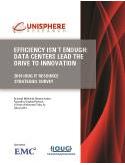
In 2014 the spotlight is on data management departments as they lead the effort to deliver competitive advantage from Big Data analytics. Decision makers seek information from a growing range of data sources and sophisticated toolsets. Managing the integration of myriad networks, data systems, and applications to deliver reliable information is a greater challenge than ever before.
The capacity to expand into new ventures requires a data management function that is capable of supporting new challenges and even taking a leadership role. While enterprises rely more than ever on IT and data managers to deliver this competitive edge, these managers report that their departments and resources still tend to be mired in low-level database administration tasks, such as performing upgrades, fixes and patches, maintaining uptime and availability, and creating and maintaining copies of database information. Data management departments need to increase their output and productivity. But mere efficiency is not enough—IT and data managers need to make innovation a larger part of their jobs.
Key highlights and findings from the survey, which explore IT and database resource issues, include the following:
- IT budgets keep gaining strength, with about half of IT and data managers anticipating growth in the next 12 months. However, significant portions of budgets are going to database maintenance, versus supporting new technology initiatives.
- Along with budget shares, IT and data managers report that significant amounts of their time are also being devoted to routine maintenance activities. Close to half report that this has been on the increase.
- Activities taking up the most IT budget resources include performing upgrades, fixes and patches, maintaining uptime and availability, and creating and maintaining copies of database information. Activities eating away the most staff time include performance tuning and diagnosis, maintaining uptime and availability, and applying upgrades, fixes and patches.
- Enterprises are turning to standardized technologies, automation, and virtualization in efforts to tighten up their budgets and make more room for innovation. Two-thirds agree that decreasing the maintenance portion of IT and data budgets will help fund new value-added activities.
- Only one out of six enterprises have been able to reduce the portion of their IT budgets spent on routine database management tasks to less than 10%. These “leaders” report greater levels of automation, but are more inclined to be seeking additional funding for new projects
Efficiency Isn’t Enough: Data Centers Lead the Drive to Innovation— 2014 IOUG IT Resource Strategies Survey was produced by Unisphere Research in partnership with the Independent Oracle Users Group and sponsored by EMC Corporation.